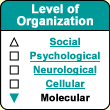|
|

 |
 |
 |
 |

 |
 |
 |

 |
 |

 |
The protein casein
kinase 1 epsilon (CSNK1E), which is the equivalent
in mammals of the DOUBLE-TIME protein in the fruit
fly, plays three different roles in the human biological
clock. First, this protein phosphorylates the PER proteins
produced in the cytoplasm, makes them less stable, and
accelerates their degradation. Second, CSNK1E helps the
PER/CRY and PER/PER complexes to penetrate the cell nucleus.
And third, CSNK1E is found inside the nucleus, where it
is involved in the degradation of the inhibitory complex
formed by the PER/CRY and PER/PER complexes.
This triple role makes it easier to
understand why a mutation that affects just one amino acid
in CSNK1E could significantly shorten the body’s circadian
period. This is what happens with the tau mutation in
golden hamsters–the first mutation discovered to affect
the circadian period of a mammal. This discovery was made
by U.S. neuroscientists Martin Ralph and Michael Menaker
in 1988.
This mutation makes CSNK1E less effective
in phosphorylating PER protein molecules, so they accumulate
in the cytoplasm faster, enter the nucleus faster, and inhibit
the per gene’s production of PER protein more
quickly. Thus, the overall result is that hamsters with the tau mutation
have shorter circadian cycles than normal hamsters.
Ralph and Menaker found that while
hamsters that did not have the tau mutation had
circadian cycles with a period of about 24 hours, hamsters
that were heterozygous for this mutation (had it on only
one of the two genes for CSNK1E) had circadian periods of
about 22 hours, and hamsters that were homozygous for this
mutation (had it on both of these genes) had circadian periods
of about 20 hours.
Similar mutations in the CSNK1E genes
also produce shorter circadian periods in humans. But recent
studies seem to have revealed other mechanisms that are far
more complex.
|
|
|
The circadian rhythms (from the Latin circa dies,
meaning “around
a day”) that are observed both in plants and in animals are
produced by a biological clock that operates
in a negative feedback loop. This kind of loop is very common
in biological organisms, but ones with such a long period as this–about
24 hours–are far rarer. Most feedback loops in living organisms
have periods on the order of a minute, a second, or even a millisecond.
The various genes involved in this very special
24-hour loop were first isolated in the fruit fly, Drosophila,
in the early 1970s (follow the History Module link to the left).
In the late 1990s, the equivalent genes were isolated in mice and
in humans. In addition, these genes were found to be expressed
in the neurons of the suprachiasmatic
nuclei of the hypothalamus, which was consistent with the role
that these neurons were known to play in controlling the circadian
rhythm.
At the molecular level, the role of each of the main components
in the human biological clock can be described as follows (bear
in mind that each of these components often has several
sub-types with slightly different functions). The two mainsprings
of this mechanism are the period (per) gene and
the cryptochrome (cry) gene. These genes cannot
be active unless two protein molecules, CLOCK and BMAL1, linked
to each other to form a complex, bind to a specific site on the
genes’ DNA sequences, known as the E-box element. When this
complex binds to the E-box elements of the per and cry genes,
it enables their DNA to be transcribed into messenger RNA (mRNA).
Unlike the genes’ DNA, their mRNA can exit the nucleus through
the nuclear pores and enter the cytoplasm, where it is translated
into the proteins PER and CRY, respectively, by the cell’s
ribosomes.
The protein PER degrades rapidly unless
it too forms a complex. This complex may consist either of PER
molecules (a PER/PER complex) or of PER molecules and CRY molecules
(a PER/CRY complex). These two types of complexes then penetrate
the cell’s nucleus,
where they interact with the CLOCK/BMAL1 complexes so as to render
them, and hence the per and cry genes, inactive.
Thus the negative feedback loop is formed: by inhibiting these
genes from which they originated, the PER and CRY proteins end
up inhibiting their own production.
After a while, however, the PER/PER and PER/CRY
complexes degrade and are replaced by other complexes that also
have entered the nucleus. Eventually, precisely because the cell
is no longer producing any PER or CRY molecules, there are no longer
enough PER/PER and PER/CRY complexes left to block the activation
of the per and cry genes.
The inhibition on the CLOCK/BMAL1 complexes is thus released, and
the transcription of per and cry mRNA resumes.
At this point, about 24 hours have elapsed since this entire cycle
began.
Source: Howard Hughes
Medical Institute
The human biological clock is extremely regular:
it is accurate to within 1%. But just like a watch that is never
absolutely accurate on its own and needs to be reset occasionally,
this biological clock needs a mechanism to prevent tiny errors
from accumulating in each cell. In other words, it needs to synchronize
itself with external signs that tell it when each new day begins.
The growing intensity of the natural light is the first sign of
daybreak, and special
photopigments in the retina detect this change in light intensity
and transmit
this information to the human biological clock.
Certain proteins involved
in the feedback loops in the human biological clock may also
be involved in controlling the cycle
of division in human cells. .
If some proteins in the biological clock are involved in the
mechanisms of cell division, then they might also be involved
in abnormalities in cellular cycles, such as the proliferation
of cancerous tumours. In mice, for example, certain disorders
of the SCN cause tumours to grow more quickly, and in humans,
certain types of cancer are more common among people who work
night shifts.
The variations in the efficacy of
certain forms of chemotherapy according to the time of
day that they are administered seem to confirm the close
linkages between cellular cycles and the biological clock.
|
|
|




